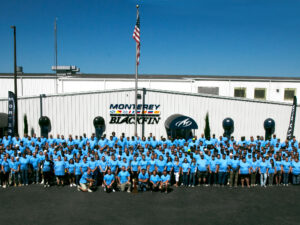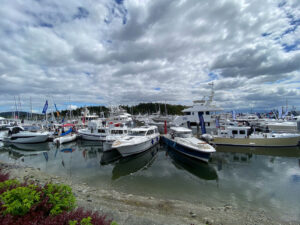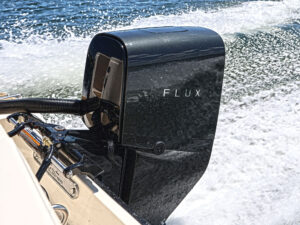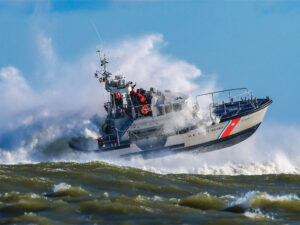Everybody whines about docking in the tight slip. What about the one that’s too big? I was charged with slipping Rinker’s 290 EC between pilings set six feet wider than the boat’s beam and 10 feet farther from the dock than the boat’s length. Getting secured without dinging the large yachts bracketing our berth was akin to playing the kids’ game Operation: Be careful shuttling within the envelope; hit the perimeter and you lose. The 290 EC is powered by a single sterndrive.
So with the steely nerves of one who wouldn’t have to write the check should things go wrong, and with the trawler captain beside us dropping polyballs over the side of his boat’s rail in anticipation, I backed her in and joggled her around, and my mate secured the lines. Key off. Pass.
Rinker drew the 290 EC to pleasing proportion. It’s neither too beamy for its length nor too tall for its beam. It’s got enough displacement, deadrise and draft to not blow around like a leaf. Old-time boatbuilders will tell you that, if it looks good, it is good, the eye trumping a line on a plan. The effects of the gusty breeze and moon currents of test day were no match for this “right-looking” boat, the torque-negating action of a Bravo Three sterndrive notwithstanding.
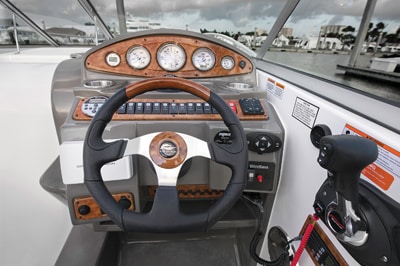
With its handling qualities confirmed, we wanted to know how the 290 EC is built. After all, a right shape is only good if the boat can hold it over time. The devil is in the details.
Fasteners securing the hull-to-deck joint are closely spaced. They are not so close to the edges of the overlapping flanges they penetrate that they’ll break out as hull and deck move and “work” in a seaway. At a minimum, this distance should be twice the fastener diameter from the edge of the flange. I observed just that aboard the 290 EC in spots such as the engine compartment and rode locker, where the joint is most easily seen.
I also noted that handholds, hatches, rails, hinges and doors were fastened with through-bolts. Many builders use screws, keeping aftermarket accessory makers in the black, plus putting your crew’s safety at risk. The American Boat and Yacht Council specifies that grab rails withstand a 400-pound force. It’s tough to make that spec using screws. I’d add that, besides official grab rails, anything that can be grabbed aboard a boat will be grabbed. Rinker’s attention in this regard throughout the 290 EC is to be applauded.
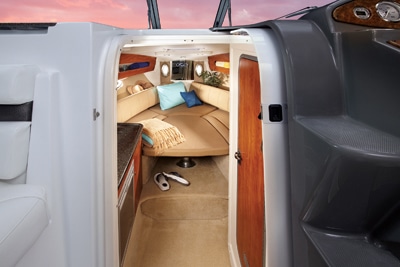
Serviceability aboard the 290 EC is great. Most midcabins of about this size have twin engines, like Chaparral’s 290 Signature ($144,322 with twin 220 hp MerCruiser 4.3L Alpha sterndrives) or Four Winns’ V305 ($181,938, also with twin 220 hp MerCruisers and Bravo Three drives). Twins offer advantages, and most of these boats are beamier than the 290 EC. But you can’t beat a single for engine access. And that’s just what I discovered aboard the 290 EC. A nice feature is the jumper posts in the cockpit that allow the skipper to open the engine hatch should power fail. (Should the lift mechanism fail, a deck plate provides access to a pull-pin on the ram). In fact, the only gripe I had with respect to maintenance aboard the 290 EC was the fact that the main electrical distribution panel (MDP) lacked illumination. A light switch like a refrigerator’s door has would be beneficial.
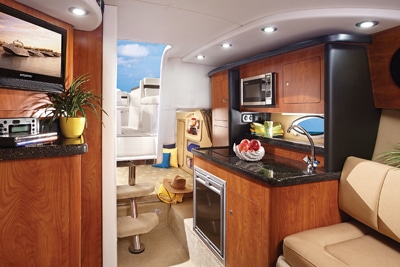
The 290 EC layout is a successful attempt to mirror the popular layout of the boat’s larger sister, the 310 EC. (Read my review of the 310 EC) There’s a transom rumble seat; the aft lounge backrest drops to form a sun pad; and a long, serpentine lounge wraps from the port side and around the transom. There’s no seating to starboard but for the helm bench: That’s where the oversize wet bar resides. The effect is a wide, fluid pathway between platform and cabin. This differs from Bayliner’s 285 SB ($95,734) and Regal’s 28 Express ($99,943), both with single 300 hp MerCruiser 350 Mag MPI Bravo Three. These have seating port and starboard, and offer dinette seating abaft the helm. The Rinker test boat’s 380 hp engine and Bravo Three X drive represent a $9,526 upcharge, worth it in my view.
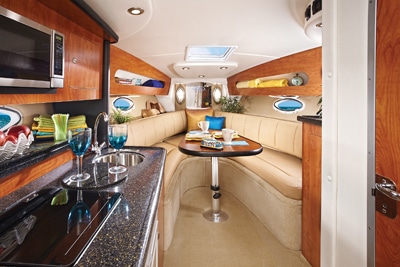
Belowdecks there’s plenty of light. Credit the translucent companionway slider, as well as Rinker’s use of more ports than some builders include, positioned strategically throughout. Touches of luxury were found in the illuminated mirror, etched with Rinker’s logo, that conceals access to the rode locker, as well as designer sconces, faux-leather upholstery, burl wood trim and a drum-tight headliner. The head is generous. It’s midcabin is big enough for adults. Easily serviced, and with excellent economy and respectable performance from a single engine, the 290 EC makes a great family cruiser. Even if next weekend’s slip proves too big.
Comparable models: Chaparral 290 Signature, Four Winns V305, Bayliner 285 SB, Regal 28 Express
**_Click here for the 290 Express Cruiser’s accomodation plan._
**
**
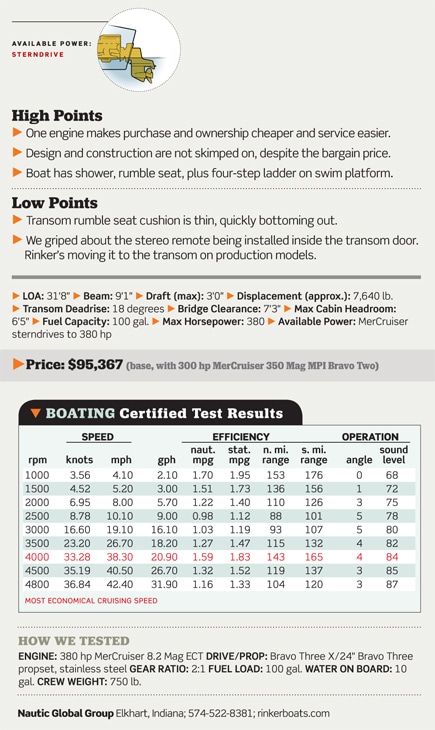
**

